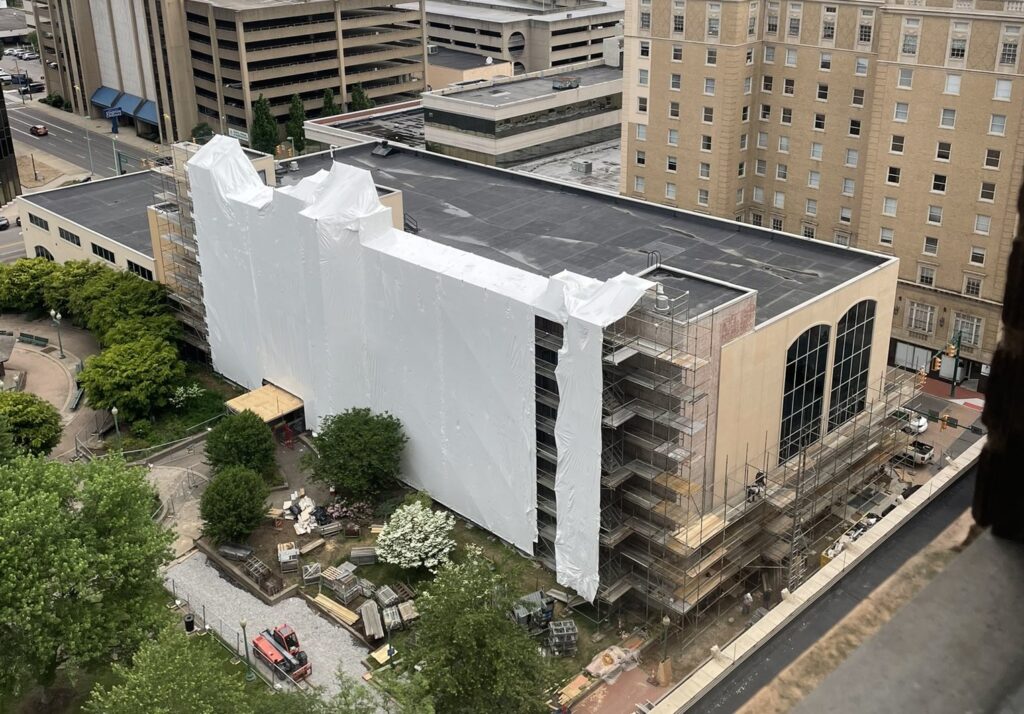The former Department of Health and Human Resources building at One Davis Square in Charleston, W.Va., on May 7, 2024. (Leann Ray | West Virginia Watch)
During the 2023 regular session, members of West Virginia’s Legislature approved House Bill 2006, which would split the state’s health department — the Department of Health and Human Resources — into three new agencies, beginning Jan. 1 of this year.
There were multiple reasons to reorganize the agency — it was too large to manage a crisis, possible organizational conflicts of interest between service providers and the offices that regulate and investigate those services, and the budget wasn’t transparent.
“With three separate budgets, we will be able to design the future budget bills so we, the legislative body, and the public can see where the money is being spent,” Del. Amy Summers, R-Taylor, said at the time. “We can also set up a process to put in place to evaluate the spends, and the effectiveness of those spends.”
Bless her heart.
Lawmakers did finally get a chance to see where the money was going, and some didn’t like what they saw. In April, they learned that DoHS had enough money to fund a pay increase for direct care workers, but instead spent it on other things, like in-home COVID-19 tests. (That caused a rift with the Senate on a bill to fund the state’s waiver program for people with disabilities; the House wanted to mandate how DoHS spent the money and the Senate didn’t. In the end, the Senate got its way.)
Also during the April interims, the department told lawmakers and child care providers that funding for child care would run out at the end of August.
As the deadline approached, our reporter Amelia Ferrell Knisely and reporters from other West Virginia news outlets reached out to DoHS to find out what was going on. Steven Allen Adams of Ogden Newspapers said he and Emily Rice of West Virginia Public Broadcasting tried to ask the Department of Human Services Secretary Cynthia Persily about it in person, but were told to email the communications director, who did not respond to his email.
This isn’t a negative story about the agency — highlighting the need to fund child care could potentially put pressure on lawmakers to find the needed money. Why wouldn’t they want to talk about that?
So reporters wrote stories talking to child care providers and legislators about how the funding was set to end with no comments from the department.
House Minority Leader Sean Hornbuckle, D-Cabell, said his caucus had tried with no luck to get information from the department about the funding issue.
The lack of communication for child providers and families was “disrespectful to the citizens of West Virginia on such an important matter,” he said.
Hours after our story was published on Aug. 22, the department posted on X, “@WVHumanServices is aware of several reports suggesting that child care centers are facing a funding crisis by the end of August. These reports are not accurate and are needlessly causing confusion and worry among child care providers and parents alike.”
Actually, the department’s directors of communications are needlessly causing confusion and worry among child care providers and parents by not responding to reporters who want to update everyone about the situation.
We’ve made it no secret that DoHS often ignores our requests for information, most often from our reporter Amelia. They’ve also ignored our lawyer when he contacted them about their refusal to respond to a FOIA request for public information under the Freedom of Information Act.
When I contacted the director of communications to try to smooth things over, I was told, “Amelia’s reporting only seeks to harm and misinform West Virginians.”
Children haven’t died because of Amelia’s reporting. But a child did die, and we asked DoHS for records to see if Child Protective Services received calls about her and if they visited the house.
You can’t say reporters are misinforming the public if you refuse to speak to them to clear things up.
But they’re not just ignoring the media and lawmakers — they weren’t responding to emails from child care providers either.
Jennifer Trippett, owner of Cubby’s Child Care Center in Bridgeport, responded to DoHS’s post that the last update she got was in April.
“How is anyone supposed to know any different when we are not answered in emails or given updated info from your office,” she wrote.
Lawmakers finally got an update on Aug. 26. Persily told them that the funding for child care centers is not in “crisis,” even though 60 child care providers have closed this year due to uncertain funding.
Persily told lawmakers that her department had a $200 million surplus, and she hasn’t yet dipped into a $180 million reserve fund created by lawmakers, which could be used to pay for the child care funding.
Instead, they’ve been using Temporary Assistance for Needy Families funds, which will run out at some point.
This sounds like a crisis.
When will the Department of Human Services stop gaslighting West Virginians? We want honesty and transparency. You are paid by West Virginans, and you must answer to them.
GET THE MORNING HEADLINES DELIVERED TO YOUR INBOX

